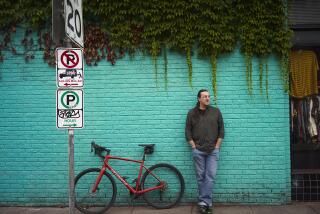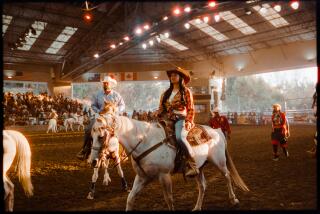BAM Battles Bias Against Bikers : Group--50,000 Strong--Helps Cyclists Help Each Other
- Share via
It’s a scene that occurs somewhere each summer when the weather heats up and motorcyclists take to the roads: A bug-flecked biker knocks a leathery knuckle on a family’s front door and asks to use the telephone because his Harley has just gone down on the highway. The father slams the door on the fellow’s plea and the mother and children cower inside, images of outlaw biker gangs flickering in their heads.
In reality, the traveler may be a harmless kid. But nobody wants to help a biker in distress, it seems--except another biker.
There’s long been a code that motorcycle riders go to the aid of their own kind; now Russ Brown, a Los Angeles attorney, has formed Bikers Against Manslaughter, an organization that formalizes the tradition of bikers helping bikers.
“This is something that motorcycle riders need,” said Rick Solomon, a 33-year-old BAM member and former motorcycle cop from Dallas, Tex., who now works in security. “We all have the same type of problems out on the road. We’re in places where we don’t know anybody and nobody knows us. If something happens, who do we call?”
Rush to Bedside
Solomon got word last November from a BAM staffer in Los Angeles that 20-year-old John House Jr. was in intensive care at a hospital in Dallas. Solomon and his wife, Linda, hurried to House’s bedside.
The young patient, they learned, had recently moved to Texas from his home in Illinois in search of work. He’d been idling at a stop sign when a motorist rammed his motorcycle from behind, leaving him with internal and head injuries.
The youth’s father, John House Sr. of Orion, Ill., was a member of BAM. As soon as the elder House learned his son was in trouble, he dialed the number on his BAM card, 1-800-4-BIKERS. This put House in contact with one of BAM’s seven full-time staff members in Los Angeles, who checked the organization’s registry of 50,000 bikers across the country. If someone who is registered is in an accident, the BAM staff is able to relay information such as blood type, special medical problems and next of kin to the caller. Members of the registry may also be called on to aid another biker, as in this case. (There is no fee for registration; the organization is supported by legal fees from Russ Brown’s law practice.)
Shortly after the patient’s mother, Ellen House, arrived at the hospital from Illinois, the Solomons were there to meet her. For the next three days, the Solomons would bring the distraught mother meals at the hospital. The Solomons picked up House Sr. at the airport when he arrived the second day, and they donated blood for the patient. (John House Jr. has since recovered and has returned to his job on an assembly line.)
Rick Solomon visited the scene of the accident to make sure that the police report reflected what actually had occurred.
Brown, 51, of Van Nuys, said BAM offers this service because police reports on motorcycle accidents are sometimes inaccurate unless the investigating officer himself is a biker.
For example, one report determined that a motorcycle was going 50 m.p.h. when it crashed, based on a formula that gauges speed according to the distance the vehicle slid. But the formula assumes an automobile sliding on four rubber tires, Brown said. When a bike goes down, metal skids across asphalt and the vehicle will slide much farther. Due to the investigation of the BAM crew, Brown said, the report in question was changed to show that the motorcyclist had been traveling 35 m.p.h. at the time of the accident, a legal speed for that particular road.
Russ Brown and his wife Hana appeared to be just another smoothly groomed pair of mid-Wilshire-area business people out for lunch on a recent afternoon. But underneath their establishment veneer is a loyalty to motorcyclists of every stripe--and that includes those who resemble what Brown calls the stereotypical “bad boy” biker.
Brown has identified with biker values ever since he was 16 and took to racing motorcycles on a quarter-mile dirt track behind a friend’s farm in Santa Maria, Calif. In the mid-’50s, he joined a motorcycle club called the Santa Maria Owls.
“I was sort of a semi-bad guy,” Brown said. He wore leather jackets, grease-stiffened jeans and a ducktail. The “good” kids used to back up against their lockers when he walked down the corridor at school, he said.
“It was all show, not much go,” he recalled. “And that’s what bikers are. They may look ferocious, they may look intimidating, they may look threatening--but they’re not.
“If you go over and just talk to them you find that they’re really low-profile people, except for their costumes.”
Part of the reluctance of non-bikers to get involved with the two-wheeler set can be traced to the lawless image of a few that tends to reflect on all motorcyclists. Last month, for instance, Atty. Gen. John Van de Kamp cited motorcycle couriers along with street hoodlums and prison inmates as sources of drug distribution in California.
‘Wild Ones’ vs. ‘Mask’
Brown said many people still seem to associate bikers with the anti-social crowd of “The Wild Ones,” a Marlon Brando movie based on a real-life incident in which bikers terrorized the town of Hollister, Calif. Yet, Brown said that a recent film, “Mask”--in which bikers accept a severely deformed boy into their clan--gives a truer picture of the nature of most bikers.
Hana Brown, 32, said she feels more at ease letting her children Aaron, 7, and Lauren, 3, run around at a bikers’ gathering than at their neighborhood park.
When Russ Brown began a small personal injury law practice, biker acquaintances started telling him tales about motorists being let off with minimum sentences after maiming or killing bikers through negligence, or even intentionally.
‘I Didn’t See Him’
The case that eventually inspired Brown to form BAM in 1982 involved a woman in her early 20s with three children. Her husband was killed by a drunken motorist who said: “I didn’t see him (the motorcycle rider).” The motorist received summary probation.
Brown concluded that the attitude toward bikers involved in highway incidents is somewhat like that toward rape victims: They must have done something to provoke the attack/accident.
For those bikers involved in accidents that land them in court, Bikers Against Manslaughter is there to ensure that prejudice against bikers doesn’t weigh the case in favor of the automobile driver.
Brown’s own practice consists almost entirely of personal injury cases involving motorcyclists. If his client looks the part of a renegade biker, Brown may insist that he remove his earring and get a haircut before appearing in court, so that a jury’s biases aren’t triggered.
Easygoing Rider
Because of his line of work, Brown said he has an exaggerated awareness of the ways a motorcyclist can get him or herself hurt or killed, so he is a much more cautious rider than he was in the days when he rode with the Santa Maria Owls, a cigarette pack bulging in his T-shirt sleeve. He still splits traffic lanes sometimes on his commute to the BAM office from his home in the valley, but never at high speeds. He’s had to lay the bike down a few times to avoid an accident, and has suffered minor injuries, but he’s never been involved in a motorcycle-auto collision.
He travels to rallies around the country on his Harley Davidson, spreading word of Bikers Against Manslaughter. Often his wife and two children go with him.
The feedback so far suggests that Brown’s efforts are appreciated:
A 67-year-old man from East Meadow, N.Y., wrote to BAM saying that his wife is relieved because now that he’s a BAM member, there’ll always be someone nearby to help him when he goes off on weeklong solo motorcycle tours.
And a woman named Sam who owns a Harley Davidson parts and service shop in East Haven, Conn., wrote suggesting that BAM may be destined to become the bikers’ equivalent of AAA.
More to Read
Sign up for Essential California
The most important California stories and recommendations in your inbox every morning.
You may occasionally receive promotional content from the Los Angeles Times.










